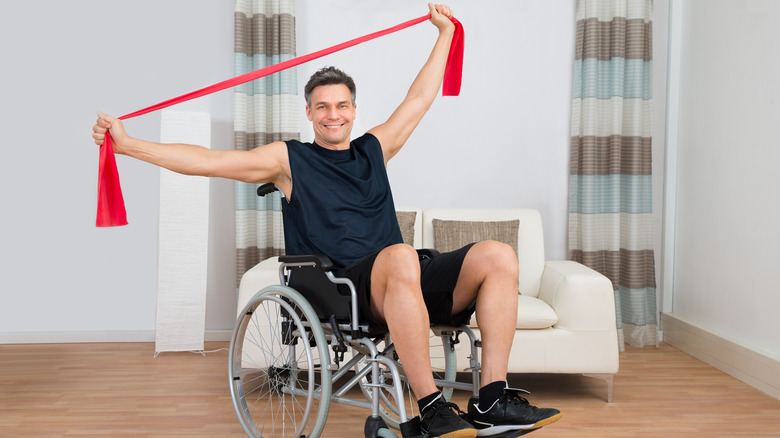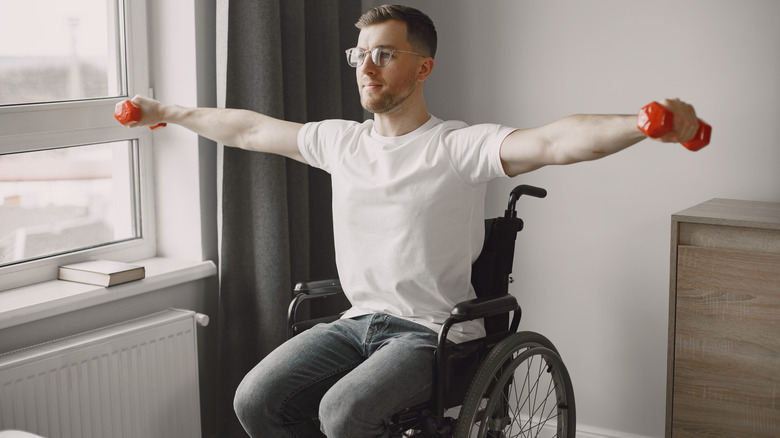Can Exercising With A Bone Fracture Help The Healing Process?
Breaking a bone can be a disappointing experience, even though you may initially be excited to have all of your friends sign your cast. Officially known as bone fractures, broken bones can happen to anyone regardless of age, and every bone in the human body is susceptible to breaking due to injury or trauma (via Cleveland Clinic). Bone fractures typically occur when blunt force impacts a bone and causes it to break, such as through a fall, vehicle accident, sports collision, or other hard hit to the body. During the healing process, there are several things you can do to make the process as smooth as possible.
Even if exercise is how you ended up with a bone fracture in the first place, finding ways to keep your body moving during the period of time when a broken bone is healing can be beneficial in both treating and preventing future bone fractures, as found in a 2020 study published in Journal of Orthopaedic Translation. Every year, nearly 178 million bone fractures occur around the globe, with the most vulnerable populations being people with osteoporosis, and the elderly, per a 2021 study published in The Lancet Healthy Longevity. It's estimated that up to 10% of bone fractures may not heal properly, therefore it's necessary to ensure thorough treatment measures are employed, as per a 2022 article published in the Journal of Cellular and Molecular Medicine. Luckily, exercise is one way to keep the body moving during bone fracture treatment.
Strength training creates stronger bones
The thought of strength training may inspire images of lifting weights in a gym, but there are many ways to participate in strength training to enhance your overall health, especially when you have a bone fracture. According to Harvard Health Publishing, strength training involving resistance bands, free weights, or machine-based weight exercises can lead to both stronger muscles and stronger bones, thus decreasing the risk of future injuries to bones. In contrast, some of the worst things that can raise a person's risk of bone fractures include a lack of an active lifestyle and a poor diet. Especially for people over the age of 40, strength training is critical because bone density and mass begin to decline as we age.
Avoiding inactivity is a key part of the fracture healing process, as found in a 2018 study published in the European Journal of Orthopaedic Surgery & Traumatology. Researchers have determined better healing comes the sooner a person can begin moving their body and engage in appropriate levels of strength training following bone fractures in the leg. Pursuing weight-bearing activity earlier in the healing process can prevent impaired healing of bone fractures. The benefits of pain-free weight-bearing activity following bone fractures are rooted in increased blood flow and oxygen that exercise promotes throughout the body, per The Conversation. Oxygen and blood flow are essential for the proper healing of bones (via a 2022 article published in StatPearls). Be sure to follow your doctor's guidance when recovering.
Ways to strength train during healing
Osteoporosis is a top cause of bone fractures because it is in nature a disorder that degrades bone density and weakens the function of bones throughout the body (via Mayo Clinic). People with osteoporosis are prone to experiencing falls that result in bone fractures, particularly in the back, spine, and hips. Though women who are postmenopausal and people who are elderly are most likely to be diagnosed with osteoporosis, the recommended exercises to strengthen bones can be good for anyone looking to improve their bone health. To combat bone fragility and potential fractures, and to speed up the healing process of a bone fracture, suggested activity focuses on improving strength, balance, and reducing pain.
When a weight-bearing exercise is conducted, bone cells called osteocytes are engaged to start the process of new bone tissue growth, per a 2021 study published in Regenerative Medicine. Because osteocytes communicate with other types of cells to speed up tissue growth, healing of bone fractures can be made quicker with the new bone tissue and the amount of time it takes for bone injuries to heal is decreased. Weight-bearing exercises and strength training while recovering from a bone fracture can include activities like walking, swimming, stretching with a resistance band, or climbing stairs, suggests WebMD. Balance and flexibility are also important following bone fractures, so try incorporating tai chi, yoga, or going for meditative walks. Exercises that improve range of motion are highly encouraged.



